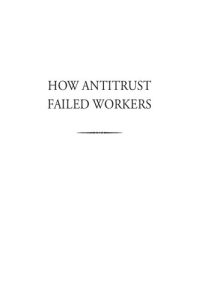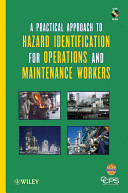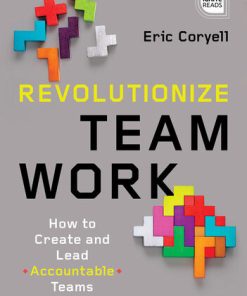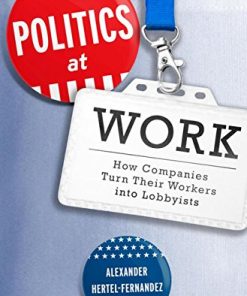How Antitrust Failed Workers 1st Edition Eric A. Posner
$50.00 Original price was: $50.00.$25.00Current price is: $25.00.
How Antitrust Failed Workers – Ebook Instant Download/Delivery ISBN(s): 9780197507629,019750762X,9780197507643, 0197507646
Product details:
- ISBN 10: 0197507646
- ISBN 13: 9780197507643
- Author: Eric A. Posner
A trenchant account of an unacknowledged driver of inequality and wage stagnation in America: the failure of antitrust law to prevent the consolidation of employers, who use their market power to suppress wages. Since the 1970s, Americans have seen inequality skyrocket–and job opportunities stagnate. There are many theories of why this happened, including the decline of organized labor, changes in technology, and the introduction of tax policies that favored the rich. A missing piece of the puzzle is the consolidation of employers, which has resulted in limited competition in labor markets. This should have been addressed by antitrust law, but was not. In How Antitrust Law Failed Workers, Eric Posner documents the failure of antitrust law to address labor market concentration. Only through reforming antitrust law can we shield workers from employers’ overwhelming market power. Antitrust law is well-known for its role in combatting mergers, price-fixing arrangements, and other anticompetitive actions in product markets. By opposing these practices, antitrust law enhances competition among firms and keeps prices low for goods and services. Less well-known, antitrust law also applies to anticompetitive conduct by employers in labor markets, which pushes wages below the competitive rate. Yet there have been few labor market cases or enforcement actions, and almost no scholarly commentary on the role of antitrust law in labor markets. This book fills the gap. It explains why antitrust law has failed to address labor market concentration, and how it can be reformed so that it does a better job.Essential reading for anyone interested in fighting economic inequality, How Antitrust Failed Workers also offers a sharp primer on the true nature of the American economy—one that is increasingly uncompetitive and tilted against workers.
Table contents:
Part I Labor Monopsony and Antitrust Law
1. Labor Monopsony in the United States
1.1. The Intellectual History of Monopsony
1.2. The Sources of Monopsony Power
1.3. Measuring Market Power
1.4. Evidence of Labor Market Power
1.5. Implications for Wages and Employment
2. The Failure of Antitrust
2.1. Background on Antitrust Law
2.2. The Litigation Gap
Part II Reform
3. Collusion
3.1. The Law
3.2. Is Labor Market Collusion Different from Product Market Collusion?
3.3. Parallelism
3.4. No-Poaching Agreements in Franchises
3.5. Vertical Agreements
4. Monopsony
4.1. The Law
4.2. What Is a Labor Market?
4.3. Labor Markets: Monopsony, Concentration, and Elasticity
4.4. Anticompetitive Acts
4.5. Reform
5. Mergers
5.1. Market Concentration
5.2. Downward Wage Pressure
5.3. Other Factors in Merger Analysis
Appendix. Case Study: The Effect of Hospital Mergers on the Labor Market for Nurses
6. Noncompetes
6.1. The Law of Noncompetes
6.2. The Benefits of Noncompetes for Labor Markets
6.3. The Social Costs of Noncompetes
6.4. Antitrust and Noncompetes
6.5. How Can Noncompetes Be Challenged under Antitrust Law?
Part III Beyond Antitrust
7. The Limits of Antitrust
7.1. Labor Markets versus Product Markets (Again)
7.2. Evidence
8. Employment and Labor Law: Old and New Directions
8.1. Wage Regulation
8.2. Tax and Transfer Policies
8.3. Mandatory Benefits
8.4. Job Protection
8.5. Occupational Licensing
8.6. Government Subsidies, Including Training and Employment
8.7. Job Standardization
8.8. Support for Unions
8.9. Shareholder Activism/Codetermination
9. The Gig Economy and Independent Contractors
9.1. Discrete and Relational Work
9.2. Market Structure
9.3. Misclassification
9.4. The Misclassification Debate
9.5. Misclassification and Antitrust
People also search:
how antitrust laws encourage competition
how does antitrust work
how do antitrust laws affect the economy
antitrust what went wrong and how to fix it
do antitrust laws prevent monopolies
You may also like…
Business & Economics
Politics & Philosophy - Social Sciences
Politics & Philosophy
Business & Economics
Chinese Antitrust Exceptionalism: How the Rise of China Challenges Global Regulation
Politics & Philosophy - Social Sciences
Politics at Work: How Companies Turn Their Workers into Lobbyists 1st Edition













